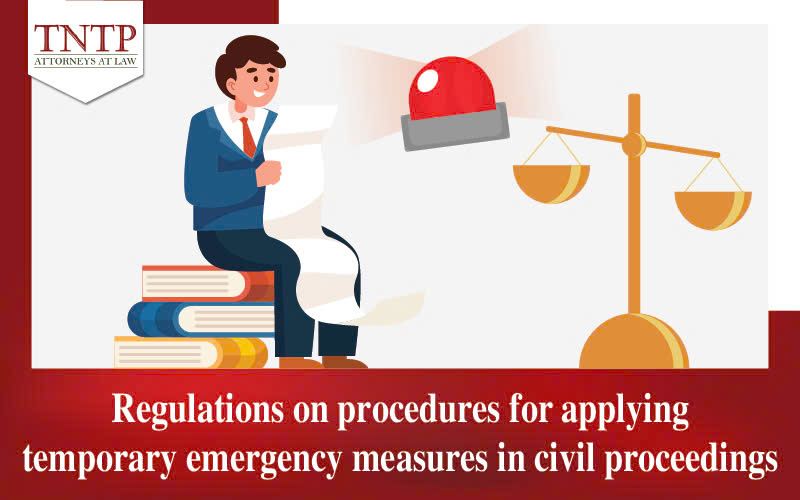Regulations on Procedures for Applying Temporary Emergency Measures in Civil Proceedings

Temporary Emergency Measures are court-ordered actions designed to address urgent situations in civil cases. The procedure for applying such measures in civil proceedings is understood as the court carrying out processes in accordance with legal regulations to issue a decision on the application of these measures. Within this article, TNTP will focus on analysing the procedures for applying Temporary Emergency Measures in civil proceedings.
1. Application of Temporary Emergency Measures During the Pre-Trial Stage
At this stage, the procedure for applying Temporary Emergency Measures is carried out as follows:
Step 1: Submission of the Application and Supporting Evidence
The person requesting the application of Temporary Emergency Measures (hereinafter referred to as “the applicant”) must submit an application along with relevant documents and evidence to the competent court.
When immediate judicial intervention is required to protect legal rights and interests, the lawful representative of the litigant, or a relevant agency, organization, or individual, must apply with the competent court.
The application for Temporary Emergency Measures (hereinafter referred to as “the application”) must include the following basic information:
– Date of submission;
– Name and address of the applicant, the person against whom the measures are requested, and, if applicable, any person with legal rights and interests requiring protection;
– A summary of the dispute or act violating legal rights and interests, clearly stating the necessity of applying the Temporary Emergency Measures;
– The specific Temporary Emergency Measures requested.
The applicant must also submit all relevant documents and evidence to substantiate the necessity and legality of applying the requested Temporary Emergency Measures.
Step 2: Receipt and Review by the Court
a. When the application is submitted simultaneously with the lawsuit petition, including cases where the court receives the application outside working hours
– Upon receipt of the application, the receiving officer must immediately report to the Chief Justice of the court for the assignment of a judge to handle and review the request.
– Within 48 hours of assignment, the judge must review the application and supporting evidence to determine the following:
– If the Court lacks jurisdiction, the lawsuit petition, the application, and accompanying evidence must be returned to the applicant.
– If the Court receiving the petition is not competent to handle the case, it must transfer the petition, application, and accompanying evidence to the competent court.
– If the Court is competent, the judge will proceed to review the application.
b. When the application is submitted during the trial process
– Within 03 days of receiving the application, the assigned judge must review the application and evidence to determine the necessity of the Temporary Emergency Measures.
– The judge may require the applicant to amend or supplement the application if it does not comply with legal requirements in terms of form or content.
– The judge may also request additional evidence to confirm the conditions for applying the Temporary Emergency Measures.
– If necessary, the judge may conduct verification or collect additional documents and evidence from relevant agencies, organisations, or individuals.
Step 3: Requiring the Applicant to Provide Security
If the applicant is required to provide security, the judge must immediately notify the applicant in writing. The applicant must carry out the required security measures promptly and submit proof to the court. The time for providing security must not exceed the time limit for reviewing and deciding on the application.
If the applicant is not required to provide security, the judge will proceed to review and decide on the application.
Step 4: Issuing a Decision
After reviewing the conditions for applying Temporary Emergency Measures, the judge must issue a decision and send it immediately to the civil enforcement agency, the relevant procuracy, and any related agencies, organizations, or individuals. If the application is not approved, the judge must notify the applicant in writing, stating the reasons for rejection.
2. Application of Temporary Emergency Measures During Trial
In cases where the Trial Panel receives a request during the court hearing, upon receipt of the request, the Trial Panel must review, deliberate, and resolve the matter immediately in the courtroom, addressing the following scenarios:
– If the application is approved and the applicant is not required to provide security, the Trial Panel will issue a decision to apply the measures immediately;
– If the application is approved and the applicant is required to provide security, the Trial Panel will issue the decision after the applicant submits proof of having provided the required security;
– If the evidence supporting the application is insufficient, the Trial Panel may adjourn the trial for up to 2 working days and request the applicant to provide additional evidence;
– If the application is rejected, the Trial Panel must notify the applicant during the trial, and the rejection must be recorded in the trial minutes.
This concludes the article “Regulations on Procedures for Applying Temporary Emergency Measures in Civil Proceedings” presented by TNTP. We hope this article proves useful to readers.
Sincerely,


